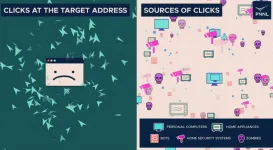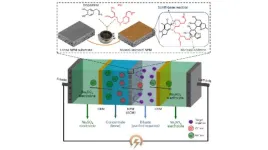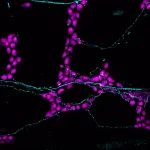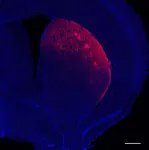(Press-News.org) RICHLAND, Wash.—Scientists have developed a better way to recognize a common internet attack, improving detection by 90 percent compared to current methods.
The new technique developed by computer scientists at the Department of Energy’s Pacific Northwest National Laboratory works by keeping a watchful eye over ever-changing traffic patterns on the internet. The findings were presented on August 2 by PNNL scientist Omer Subasi at the IEEE International Conference on Cyber Security and Resilience, where the manuscript was recognized as the best research paper presented at the meeting.
The scientists modified the playbook most commonly used to detect denial-of-service attacks, where perpetrators try to shut down a website by bombarding it with requests. Motives vary: Attackers might hold a website for ransom, or their aim might be to disrupt businesses or users.
Many systems try to detect such attacks by relying on a raw number called a threshold. If the number of users trying to access a site rises above that number, an attack is considered likely, and defensive measures are triggered. But relying on a threshold can leave systems vulnerable.
“A threshold just doesn’t offer much insight or information about what it is really going on in your system,” said Subasi. “A simple threshold can easily miss actual attacks, with serious consequences, and the defender may not even be aware of what’s happening.”
A threshold can also create false alarms that have serious consequences themselves. False positives can force defenders to take a site offline and bring legitimate traffic to a standstill—effectively doing what a real denial-of-service attack, also known as a DOS attack, aims to do.
“It’s not enough to detect high-volume traffic. You need to understand that traffic, which is constantly evolving over time,” said Subasi. “Your network needs to be able to differentiate between an attack and a harmless event where traffic suddenly surges, like the Super Bowl. The behavior is almost identical.”
As principal investigator Kevin Barker said: “You don’t want to throttle the network yourself when there isn’t an attack underway.”
Denial of service—denied
To improve detection accuracy, the PNNL team sidestepped the concept of thresholds completely. Instead, the team focused on the evolution of entropy, a measure of disorder in a system.
Usually on the internet, there’s consistent disorder everywhere. But during a denial-of-service attack, two measures of entropy go in opposite directions. At the target address, many more clicks than usual are going to one place, a state of low entropy. But the sources of those clicks, whether people, zombies or bots, originate in many different places—high entropy. The mismatch could signify an attack.
In PNNL’s testing, 10 standard algorithms correctly identified on average 52 percent of DOS attacks; the best one correctly identified 62 percent of attacks. The PNNL formula correctly identified 99 percent of such attacks.
The improvement isn’t due only to the avoidance of thresholds. To improve accuracy further, the PNNL team added a twist by not only looking at static entropy levels but also watching trends as they change over time.
Formula vs. formula: Tsallis entropy for the win
In addition, Subasi explored alternative options to calculate entropy. Many denial-of-service detection algorithms rely on a formula known as Shannon entropy. Subasi instead settled on a formula known as Tsallis entropy for some of the underlying mathematics.
Subasi found that the Tsallis formula is hundreds of times more sensitive than Shannon at weeding out false alarms and differentiating legitimate flash events, such as high traffic to a World Cup website, from an attack.
That’s because the Tsallis formula amplifies differences in entropy rates more than the Shannon formula. Think of how we measure temperature. If our thermometer had a resolution of 200 degrees, our outdoor temperature would always appear to be the same. But if the resolution were 2 degrees or less–like most thermometers–we’d detect dips and spikes many times each day. Subasi showed that it’s similar with subtle changes in entropy, detectable through one formula but not the other.
The PNNL solution is automated and doesn’t require close oversight by a human to distinguish between legitimate traffic and an attack. The researchers say that their program is “lightweight”—it doesn’t need much computing power or network resources to do its job. This is different from solutions based on machine learning and artificial intelligence, said the researchers. While those approaches also avoid thresholds, they require a large amount of training data.
Now, the PNNL team is looking at how the buildout of 5G networking and the booming internet of things landscape will have an impact on denial-of-service attacks.
“With so many more devices and systems connected to the internet, there are many more opportunities than before to attack systems maliciously,” Barker said. “And more and more devices like home security systems, sensors and even scientific instruments are added to networks every day. We need to do everything we can to stop these attacks.”
The work was funded by DOE’s Office of Science and was done at PNNL’s Center for Advanced Architecture Evaluation, funded by DOE’s Advanced Scientific Computing Research program to evaluate emerging computing network technologies. PNNL scientist Joseph Manzano is also an author of the study.
# # #
END
Engineers have developed a new kind of membrane that separates chemicals within wastewater so effectively that they can be reused, presenting a new opportunity for industries to improve sustainability, while extracting valuable by-products and chemicals from wastewater.
Created for use in wastewater treatment, the thin-film composite nanoporous membrane known as a TFC NPM, exhibits an ‘unprecedented’ capability to separate salts and other chemical components from water, and could lead to more sustainable treatment and management of water in a range of industries.
A research ...
CHAMPAIGN, Ill. — CAR-T immune therapies could be effective against solid tumors if the right targets are identified, a new study led by University of Illinois Urbana-Champaign researchers suggests. The researchers successfully deployed CAR-T in a mouse model of ovarian cancer, a type of aggressive, solid-tumor cancer that has eluded such therapies until now.
“Even with an advanced stage tumor model, even with a single dose, we saw strong anti-tumor effects,” said Diana Rose Ranoa, ...
CHAMPAIGN, Ill. — Depression is a complex condition correlated with multiple differences in brain function and mechanisms. A new paper spanning known data about the neurotransmitter GABA and its principal receptors showcases evidence of the receptors’ importance in depression and potential as therapeutic targets.
Based on evidence from research on the receptors’ function in the brain and the drugs that can activate or inhibit them, the authors propose possible mechanisms by which GABA-modulating treatments could ...
DENVER/Aug. 3, 2023 – A newly funded study will evaluate the potential of a cancer drug to control tumor growth and improve outcomes for dogs with histiocytic sarcoma, an aggressive and typically fatal canine cancer.
The multi-center clinical trial is being conducted at Michigan State University, University of Florida, University of Wisconsin and Virginia Tech, and funded by the Bernese Mountain Dog Club of America through Morris Animal Foundation's Donor-Inspired Study program. Histiocytic sarcoma was ...
LA JOLLA, CA—Gastrointestinal and digestive issues impact roughly 3 million people across the United States alone, and that number is growing. A new study from Scripps Research scientists shows how sensory neurons control our gastrointestinal tracts—critical information that could shape our understanding of related diseases and disorders.
The study, published in the journal Cell on Aug. 3rd, 2023, used a combination of human clinical data and animal models to reveal that the receptor PIEZO2 controls gastrointestinal transit through the stomach, small intestine, and colon by sensing the presence of food and slowing the rate of gut motility accordingly. These ...
Immune system T cells that should be able to kill cancer cells become dysfunctional or “exhausted” within hours of encountering a tumor, according to a study reported Aug. 3 in Nature Immunology.
The surprising findings have implications for cancer immunotherapies that aim to harness the tumor-killing power of T cells, and they challenge existing ideas about how T cells become exhausted, said Mary Philip, MD, PhD, assistant professor of Medicine in the Division of Hematology and Oncology ...
DURHAM, N.C. – Four years ago, a report that a common species of fungus might fuel pancreatic cancer offered a promising new view of the deadly disease.
But in working to validate the finding, Duke Health researchers have found no such association. In a study appearing online Aug. 3 in the journal Nature, the Duke researchers conducted a multi-pronged analysis of data from the earlier study and found no link between the pancreatic microbiome and the development of pancreatic cancer.
“We were intrigued by the original finding, as were ...
Dopamine: It’s not just for rewards anymore.
In a new Northwestern University-led study, researchers identified and recorded from three genetic subtypes of dopamine neurons in the midbrain region of a mouse model.
Although there is a long-standing, common assumption that most — if not all — dopamine neurons solely respond to rewards or reward-predicting cues, the researchers instead discovered that one genetic subtype fires when the body moves. And, even more surprisingly, these neurons curiously do not respond to rewards at all.
Not only ...
RESEARCH SUMMARY
Study Title: Mammalian SWI/SNF chromatin remodeling complexes promote tyrosine kinase inhibitor resistance in EGFR-mutant lung cancer
Publication: Cancer Cell
Dana-Farber Cancer Institute Senior and Lead Authors: Cigall Kadoch, PhD; Claudia Gentile, PhD; Akshay Sankar
Study Summary:
When lung cancers driven by mutations in the EGFR gene become resistant to osimertinib or other targeted therapies, epigenetic changes, rather than genetic changes, are often to blame. In a new study in Cancer Cell, researchers at the Dana-Farber Cancer Institute and Yale Cancer Center show that the main source of these changes are ...
About 55 million years ago, the Atlantic Ocean was born. Until then, Europe and America were connected. As the continents began to move apart, the Earth’s crust between them ruptured, releasing large volumes of magma. This rift volcanism has led to the formation of large igneous provinces (LIPs) in several places around the world. One such LIP was formed between Greenland and Europe and now lies several kilometres below the ocean surface. An international drilling campaign led by Christian Berndt from the GEOMAR ...




